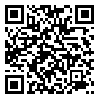Volume 68, Issue 8 (November 2010)
Tehran Univ Med J 2010, 68(8): 459-464 |
Back to browse issues page
Download citation:
BibTeX | RIS | EndNote | Medlars | ProCite | Reference Manager | RefWorks
Send citation to:



BibTeX | RIS | EndNote | Medlars | ProCite | Reference Manager | RefWorks
Send citation to:
Khorasani G, Hasani O, Farahvash M. Comparison of Septocolumellar Suture (SCS) and Lateral Crural Overlay (LCO) methods on nasal tip projection and rotation in rhinoplasty. Tehran Univ Med J 2010; 68 (8) :459-464
URL: http://tumj.tums.ac.ir/article-1-5651-en.html
URL: http://tumj.tums.ac.ir/article-1-5651-en.html
1- Department of Plastic and Reconstructive Surgery, Imam Khomeini Hospital Complex, Tehran University of Medical Sciences, Tehran, Iran. , Khorasani@tums.ac.ir
2- Department of Plastic and Reconstructive Surgery, Imam Khomeini Hospital Complex, Tehran University of Medical Sciences, Tehran, Iran.
2- Department of Plastic and Reconstructive Surgery, Imam Khomeini Hospital Complex, Tehran University of Medical Sciences, Tehran, Iran.
Abstract: (6871 Views)
Background: Proper nasal tip control is a difficult step in rhinoplasty. The aim of this study was to compare the effects of two cartilage modifying methods, Septocolumellar Suture (SCS) and Lateral Crural Overlay (LCO), on nasal tip projection and rotation.
Methods: In a single-blinded clinical trial, 36 patients who were scheduled for nasal tip deprojection were enrolled. A profile photograph of face was taken from all the patients before and three months post operation. Nasofacial angles, TP:Ln ratio for assessing nasal tip projection, tip columellar angle and nasolabial angles for nasal tip rotation assessment were measured by a computer software. The patients were randomly divided into two groups that underwent open rhinoplasty.
Results: Both the LCO and SCS methods were accompanied by a significant reduction in nasofacial angle and TP:Ln ratio, there was raised nasolabial and rotation angle in comparison to preoperative values. The use of LCO method in comparison to SCS resulted in more increase in the nasolabial angle (11.83±3.05 Vs. 4.56±1.62 degree) and Rotation Angle (11.44±3.22 Vs. 1.56±1.04 degree) and resulted in more reduction in post-operative TP:Ln ratio in comparison to preoperative measures (-0.05±0.01 Vs. -0.03±0.01), however, the difference in the nasofacial angle was not significant.
Conclusion: Both cartilage modifying techniques resulted in significant reduction in the projection and increasing in the tip rotation. Lateral Crural Overlay (LCO) seems to be more effective than Septocolumellar Suture (SCS). Therefore, the SCS method is recommended for patients who need more nasal tip rotation and deprojection in rhinoplasty.
Methods: In a single-blinded clinical trial, 36 patients who were scheduled for nasal tip deprojection were enrolled. A profile photograph of face was taken from all the patients before and three months post operation. Nasofacial angles, TP:Ln ratio for assessing nasal tip projection, tip columellar angle and nasolabial angles for nasal tip rotation assessment were measured by a computer software. The patients were randomly divided into two groups that underwent open rhinoplasty.
Results: Both the LCO and SCS methods were accompanied by a significant reduction in nasofacial angle and TP:Ln ratio, there was raised nasolabial and rotation angle in comparison to preoperative values. The use of LCO method in comparison to SCS resulted in more increase in the nasolabial angle (11.83±3.05 Vs. 4.56±1.62 degree) and Rotation Angle (11.44±3.22 Vs. 1.56±1.04 degree) and resulted in more reduction in post-operative TP:Ln ratio in comparison to preoperative measures (-0.05±0.01 Vs. -0.03±0.01), however, the difference in the nasofacial angle was not significant.
Conclusion: Both cartilage modifying techniques resulted in significant reduction in the projection and increasing in the tip rotation. Lateral Crural Overlay (LCO) seems to be more effective than Septocolumellar Suture (SCS). Therefore, the SCS method is recommended for patients who need more nasal tip rotation and deprojection in rhinoplasty.
Type of Study: Original Article |
Send email to the article author
| Rights and permissions | |
 |
This work is licensed under a Creative Commons Attribution-NonCommercial 4.0 International License. |





